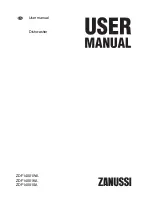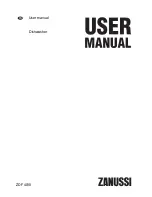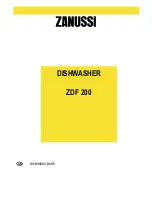
Confirmation and Preparation before Use
Preparation
■
Avoid light-weight items that may easily be blown off.
(It may cause damage, smoke, burns and odour.)
●
Plastic spoons and lid
●
Styrofoam containers
●
Sponges and dishwashing cloths
●
Baby bottle nipples
■
Avoid items that are easy to discolour or its coating are easy to peel off.
●
Silver, aluminum, copper, iron items
●
Wooden (bamboo, rattan) items
●
Lacquered, gilded, or overglaze-painted items
●
Fluorine processing pans
■
Avoid items with narrow mouth, the inside of which cannot be washed.
●
Bottles and decanters
May re-deposit
Hand wash in advance
Fine residue such as seasonings, spices or
sesame seeds may re-deposit
Toothpicks, fish bones or rubber bands may
cause valve failure
Fish skin may cause odour
Remove food residues and foreign objects
before loading
Utensils with roasted food
or steamed eggs, stubborn
stains on burnt pans that
are difficult to clean
Soak and clean up
before loading
■
The following stains may not be completely removed
■
If the items are stained with food colours (such as ketchup or curry), the pigment may adhere to the
inside of the dishwasher. Remove before loading.
• Accumulated tea rust • Lipstick stains (depends on the types) • Plastic tableware stained with food colours
■
Avoid non-heat proof items (that are easy to be deformed by heat).
●
Plastic items with a heat resistance of 90 °C or less
(including items without a heat-proof label).
●
Iron frying pans, knives
■
Avoid items that are easy to get rusted.
■
Avoid fragile items
●
Cracked, broken items
●
Crackle glaze dinnerware (tableware with crack pattern)
●
Crystal glass, tempered carved glass
●
Pans with a wooden handle
●
Other items that are not mentioned above or which you are not sure whether they should be washed
in the dishwasher, please refer to the instructions on the dishwasher detergent or contact the dealer.
Tough soils
Food
residues
Burns and
scorches
EN5
Items that are not suitable for the dishwasher.
CAUTION
Avoid tempered glasses
(which may scatter when broken, resulting in injuries)
Quick Start Guide
❶
To open the door,
❷
Loading the dishwasher
■
To close the door
Press the upper central part of the
door above the Open Door button to
close the door until the left and right
door latches are set firmly.
①
press the Open Door button,
②
open the door
Preparation
• Confirm the installation (pages EN19 - EN24) and the placement of the filter
(page EN13) are correct
• Confirm the utensils are suitable for cleaning by the dishwasher (page EN5)
• Use only dishwasher detergent. Read carefully and follow the instructions on the dishwasher detergent.
Loading the dishwasher
(pages EN7 - EN8)
Adding detergent
(page EN9)
• Select the program as needed, and press Start/Pause to start the operation.
• If you have to open the door during operation (for example, to load more items), you must press Start/Pause
and open the door slowly.
(Otherwise, washing water may spill out.)
• If you open the door without pressing Start/Pause during operation, the operation will stop.
→
Close the door and the operation will re-start.
Washing and Drying
(pages EN10 - EN11)
• Six beep sounds end the operation.
• Take out the items after 30 minutes from the completion of the operation. (When the operation is completed,
the temperature inside the dishwasher is still very high and it is easy to get burnt.)
• Cleaning the filter (page EN13)
Operation completed
Placing items improperly may result in the door not being able to open and close, causing steam leakage,
water leakage, and damage and deformation of the dishwasher and utensils, or affecting the cleaning result.
Therefore, please observe the following instructions.
1
2
3
4
5
■
Avoid overlapping the items
■
The soiled surfaces should face
inward towards the nozzles.
■
Tilt the items if they have a concave
bottom to reduce residual water.
Residual water
will be reduced.
• Items should be loaded
facing down
• Items should not block the
back nozzle
(to avoid blocking the spraying
water to clean items in the
upper basket)
• Items should not protrude
from the door
• Do not overlap the items
• Items should not protrude
outside the basket or from the
bottom of the basket, or touch
the nozzle
(Otherwise, the nozzle rotation
may stop, hence affecting the
washing result.)
• Items should be loaded with
the soiled surfaces facing
inward towards the nozzle
Clicking
EN6
Open Door
button
NP-TH1HK.indd 8
2018/11/30 15:11:17
Job Name
B685891_NP-TH1取説(香港)
Color
K
File Name
0008_NP-TH1HK.pdf
Refine Time
2018-11-30 15:16:59
Print Time
2018-12-10 15:24:55
Job Name
B685891_NP-TH1取説(香港)
Color
K
File Name
0008_NP-TH1HK.pdf
Refine Time
2018-11-30 15:16:59
Print Time
2018-12-10 15:24:55
English
Confirmation and Preparation before Use
Preparation
■
Avoid light-weight items that may easily be blown off.
(It may cause damage, smoke, burns and odour.)
●
Plastic spoons and lid
●
Styrofoam containers
●
Sponges and dishwashing cloths
●
Baby bottle nipples
■
Avoid items that are easy to discolour or its coating are easy to peel off.
●
Silver, aluminum, copper, iron items
●
Wooden (bamboo, rattan) items
●
Lacquered, gilded, or overglaze-painted items
●
Fluorine processing pans
■
Avoid items with narrow mouth, the inside of which cannot be washed.
●
Bottles and decanters
May re-deposit
Hand wash in advance
Fine residue such as seasonings, spices or
sesame seeds may re-deposit
Toothpicks, fish bones or rubber bands may
cause valve failure
Fish skin may cause odour
Remove food residues and foreign objects
before loading
Utensils with roasted food
or steamed eggs, stubborn
stains on burnt pans that
are difficult to clean
Soak and clean up
before loading
■
The following stains may not be completely removed
■
If the items are stained with food colours (such as ketchup or curry), the pigment may adhere to the
inside of the dishwasher. Remove before loading.
• Accumulated tea rust • Lipstick stains (depends on the types) • Plastic tableware stained with food colours
■
Avoid non-heat proof items (that are easy to be deformed by heat).
●
Plastic items with a heat resistance of 90 °C or less
(including items without a heat-proof label).
●
Iron frying pans, knives
■
Avoid items that are easy to get rusted.
■
Avoid fragile items
●
Cracked, broken items
●
Crackle glaze dinnerware (tableware with crack pattern)
●
Crystal glass, tempered carved glass
●
Pans with a wooden handle
●
Other items that are not mentioned above or which you are not sure whether they should be washed
in the dishwasher, please refer to the instructions on the dishwasher detergent or contact the dealer.
Tough soils
Food
residues
Burns and
scorches
EN5
Items that are not suitable for the dishwasher.
CAUTION
Avoid tempered glasses
(which may scatter when broken, resulting in injuries)
Quick Start Guide
❶
To open the door,
❷
Loading the dishwasher
■
To close the door
Press the upper central part of the
door above the Open Door button to
close the door until the left and right
door latches are set firmly.
①
press the Open Door button,
②
open the door
Preparation
• Confirm the installation (pages EN19 - EN24) and the placement of the filters
(page EN13) are correct
• Confirm the utensils are suitable for cleaning by the dishwasher (page EN5)
• Use only dishwasher detergent. Read carefully and follow the instructions on the dishwasher detergent.
Loading the dishwasher
(pages EN6 - EN8)
Adding detergent
(page EN9)
• Select the program as needed, and press Start/Pause to start the operation.
• If you have to open the door during operation (for example, to load more items), you must press Start/Pause
and open the door slowly.
(Otherwise, washing water may spill out.)
• If you open the door without pressing Start/Pause during operation, the operation will stop.
→
Close the door and the operation will re-start.
Washing and Drying
(pages EN10 - EN11)
• Six beep sounds end the operation.
• Take out the items after 30 minutes from the completion of the operation. (When the operation is completed,
the temperature inside the dishwasher is still very high and it is easy to get burnt.)
• Cleaning the filter (page EN13)
Operation completed
Placing items improperly may result in the door not being able to open and close, causing steam leakage,
water leakage, and damage and deformation of the dishwasher and utensils, or affecting the cleaning result.
Therefore, please observe the following instructions.
1
2
3
4
5
■
Avoid overlapping the items
■
The soiled surfaces should face
inward towards the nozzles.
■
Tilt the items if they have a concave
bottom to reduce residual water.
Residual water
will be reduced.
• Items should be loaded
facing down
• Items should not block the
back nozzle
(to avoid blocking the spraying
water to clean items in the
upper basket)
• Items should not protrude
from the door
• Do not overlap the items
• Items should not protrude
outside the basket or from the
bottom of the basket, or touch
the nozzle
(Otherwise, the nozzle rotation
may stop, hence affecting the
washing result.)
• Items should be loaded with
the soiled surfaces facing
inward towards the nozzle
Clicking
EN6
Open Door
button
NP-TH1HK.indd 9
2018/12/10 15:12:09
Job Name
B685891_NP-TH1取説(香港)
Color
K
File Name
0009_NP-TH1HK.pdf
Refine Time
2018-12-10 15:13:42
Print Time
2018-12-10 15:24:56






































